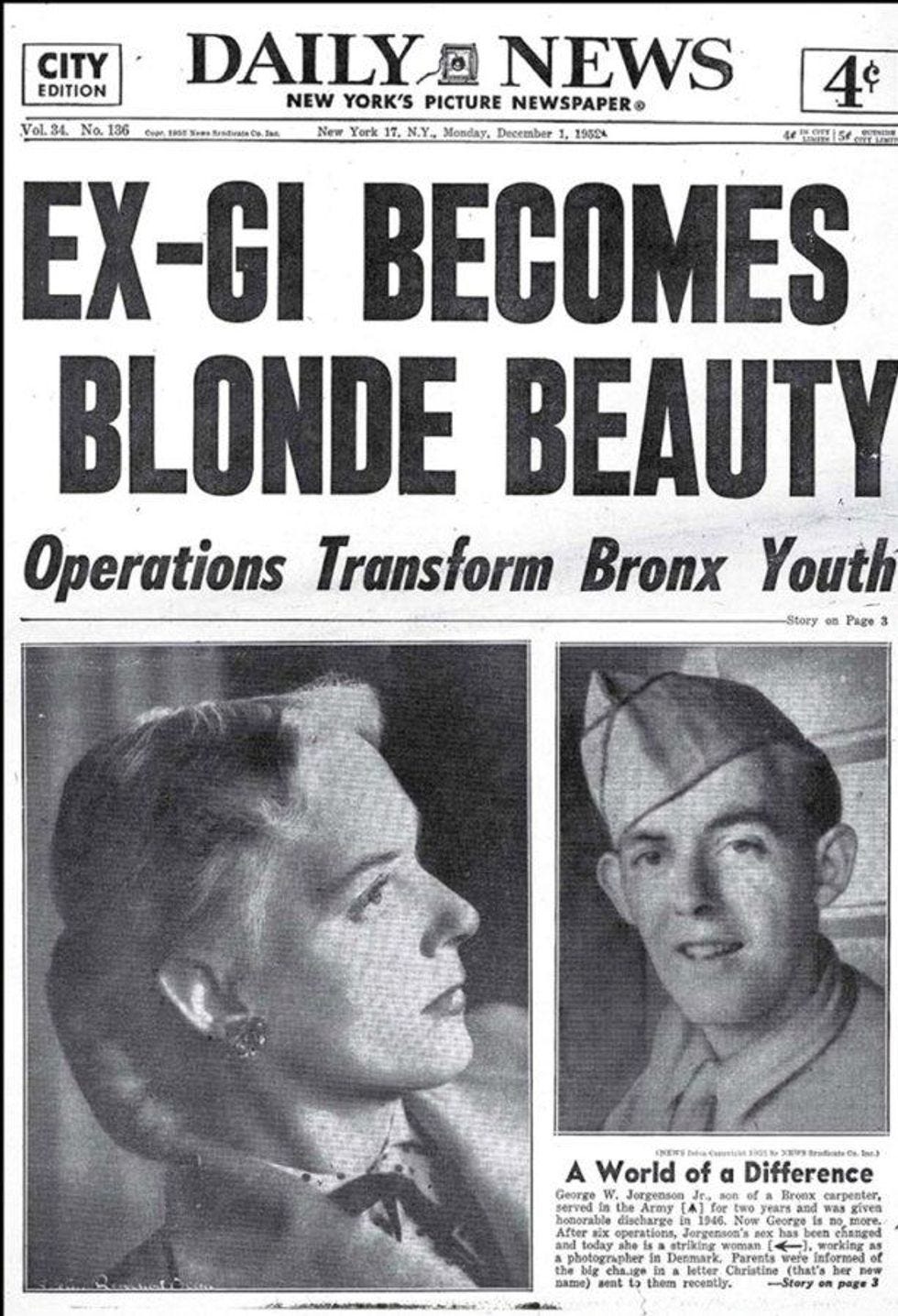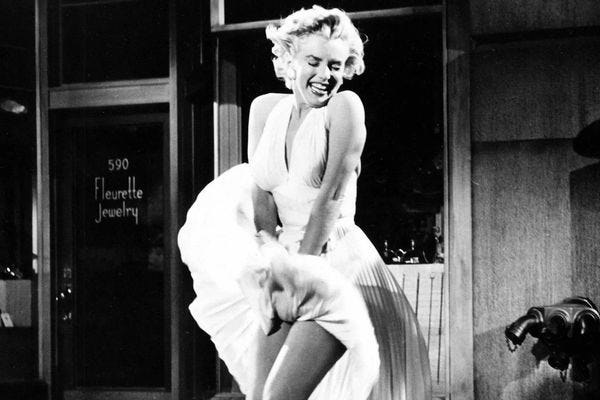The Federalist: You're Not Hot For Marilyn Monroe, You're Hot For Traditional 1950s Morals
Written by a person who has absolutely never seen a single Marilyn Monroe movie.
If there is anything I learned working in a vintage shop, it is that Marilyn Monroe people are kind of annoying. By this I don't mean fans of her movies, but rather those who see her more as a "Choose Your Own Adventure" or "Rorschach test" icon, frequently embodying what they personally think is alluring about their own selves or their own ideals and who, very frequently, have not actually watched any of her movies. She is not someone people like being terribly realistic about, as evidenced by the myriad quotations incorrectly attributed to her. But perhaps that's just what we do when we assign a human being the role of "sex symbol." Once a person is supposed to symbolize something much larger than themselves, the truth about who they were or are tends to fizzle away.
Said fizzle leads us to one of the stupidest things ever written about Monroe, courtesy of The Federalist — which argues that the reason she is so iconic is because we all actually secretly lust after ... 1950s morals.
This point is argued by Beth Whitehead, a journalism major at Patrick Henry college, known to conservative Christians as "God's Harvard" and to the rest of the world as a hotbed of sexual assault (frequently by former members of Congress) where women are frequently told they are to blame for making men "stumble" and accidentally rape them.
Ah, traditional American values.
Whitehead writes:
Our culture’s fixation with Marilyn Monroe flows largely from the dichotomy between her image and her era. Monroe was a sex symbol in a Hollywood wholly unknown to the modern viewer — one that condemned actors filming in the same bed, onscreen kisses of more than three seconds, foul or sexual language, etc. Studios didn’t drop the strict production code until 1968.
Yes, this sure is a woman who has seen a lot of Marilyn Monroe films. Fun fact, Monroe actually specifically requested a sex scene with Clark Gable in The Misfits (which would be the last film for both of them), and although it was filmed it did not become part of the movie. Why? Because that's what she thought 1961 audiences would be into.
Hollywood of the ’50s marketed desire, not sex. And there’s something about this forbearance to a modern age with no modesty that attracts us. There’s something alluring about not baring all. Marilyn Monroe is a sex symbol, but only because we never watch her have sex.
I don't know if I can post one of Marilyn Monroe's many, many nude photographs in here, but Google image search exists. They are pretty famous. You know who was also famous in the 1950s? Jayne Mansfield. No disrespect to Mariska Hargitay, but her mom kind of invented the wardrobe malfunction.
The idea that Marilyn Monroe didn't sell sex or was somehow more reserved than stars of today is patently ridiculous, and probably something that could only be said by someone who has yet to witness the cinematic train wreck that is Let's Make Love , particularly the part with the the "My Heart Belongs To Daddy" baby-voice strip tease. As wonderful as Cole Porter is, it is so much less weird to just watch people have sex.
Modern sex symbols are harder to find. Women like Megan Fox, Rihanna, and Kim Kardashian are our modern equivalents but they blend in. They fade into a culture of sexual license and become known for their talents or wealth. Promiscuity is too general now to establish one in the hall of fame. They don’t compare with Marilyn Monroe, and everyone knows it.
Because they're different people during a different era? It is unclear what is wrong with becoming known for their talent, or even their wealth, given how many men are allowed to be famous for their wealth.
What truly makes Monroe a sex symbol is the society of the ’50s.
As such, Monroe is the emblem of a community we secretly admire but don’t actually want. The one that looked down on divorce and sleeping around and drugs and had never heard of “trans.” We think we’ve liberated ourselves from this era’s moral limits, and yet when we look at many of our popular films and TV shows, we find ourselves going back to what we left.
Marilyn Monroe was a drug addict who got divorced twice. The first gender reassignment surgery was performed on Dora Richter in 1922 by the same man who would later go on to perform the same surgery on Danish artist Lili Elbe. Christine Jorgensen's gender reassignment surgery was huge news in 1952.

Ed Wood came out with Glen or Glenda a year later in 1953 — and as notoriously terrible as it was, it was in many ways a plea for compassion for those who do not fit into society's established notions about gender.
Marilyn Monroe also starred in a little movie called Some Like It Hot — and while the movie certainly plays on a lot of the typical "Oh no, it's a woman who is secretly a man!" stuff, it literally ends with Jack Lemmon's Jerry/Daphne confessing to a billionaire suitor that he is a man, and that suitor responding "Nobody's perfect!," with the clear implication that he would still like to get hitched. In retrospect, that's pretty freaking awesome for the time.
Some Like It Hot (11/11) Movie CLIP - Nobody's Perfect (1959) HD www.youtube.com
But back to this shit.
Though we deny it, we find a community set of values appealing. It brings together instead of dividing like “your truth, my truth,” and it rewards patience, commitment, and hard work unlike the modern staples of social media, porn, and video games.
Yes, people like period pieces. They even sometimes like to combine the values and aesthetics of their own era with what it is they have romanticized or imagined about previous eras.
Marilyn Monroe In "River Of No Return" - "I'm Gonna File My Claim" www.youtube.com
Notably, this is why everyone is super wrong about what people wore in the 1920s.
Whitehead continues on to explain that our society's fixation on Marilyn Monroe is somehow caught up in our desire to live in a world with traditional 1950s values despite the fact that we are unwilling to "work" for it, because we also like things the way they are.
Community standards are appealing to us, yes, but not worth the work. We might want the effects of the ’50s community standards and of the rigid moral code of Jane Austen’s world and the purpose, respect, and chivalry of its inhabitants, but we also want overt sexualization. And desire trumps sex is a hard sell.
So, we take replicate the community of conservative eras, and we think it’ll be better if we put some sex in it. We take the career of Marilyn Monroe, sprinkle in a lot of smut, and we get “Blonde,” the first original Netflix film to gain an NC-17 rating . We take the societal norms of Regency England, throw in obscene amounts of nudity and we get “Bridgerton.”
We think these hybrids will make us happy. And they do entertain — Bridgerton is the #1 most-watched English-speaking show on Netflix. And yet we betray ourselves with every nod to Marilyn Monroe. Something’s wrong, we feel it. We believe a house with no walls is no house, but we ditch the only thing that separates a man from an animal — his morals — and think we’ll be satisfied.
No. Just no. People are absolutely free to live by these moral codes if they choose to do so, or to go even further. Hell, we all remember those hipsters who decided to pretend they lived in olden times and rode penny farthing bikes everywhere. What they can't do, however, is force anyone else to live by them — which is what seems to be the real problem for Federalist writers all over.
If you will notice, however, all of the most enduring "sex symbols" of that era are those who transgressed what we think of as traditional 1950s values (one of which, notably, was racism). Marilyn Monroe, Elizabeth Taylor, Elvis, James Dean, Bettie Page, etc. No one is putting up posters of Barbara Billingsley or Doris Day on their wall.
And for the record, the Georgian Era (during which the Regency Era took place) was not nearly as uptight about sex as Whitehead would imagine. It was a period of social backlash against Puritanical values. Fanny Hill, the first pornographic novel and one of the most banned books of all time, was written during this period. People, including those in the upper classes, had illegitimate children all over the damn place. Casanova was alive and quite famous during this period, as was Madame de Stael. Prominent Whig leader Charles James Fox was a known man-slut who married a "courtesan" who was once the mistress of the Prince of Wales. There were famous courtesans all over the place, actually — Madame Du Barry, Harriet Wilson, and Marie Duplessis, the inspiration for Marguerite in La Dame Aux Camellias, remade several times as Camille, first starring famous Hollywood lesbian Alla Nazimova, known for having big ol' gay sex parties at her mansion, aka The Garden of Alla and also for being Nancy Reagan's godmother. The later talkie version starred another famous Hollywood lesbian, Greta Garbo.
Every time period is a hybrid. Every time period is simultaneously more conservative and more liberated than people now believe, and much like Marilyn Monroe, people place their own selves and values and ideals and hopes and dreams on these times in hopes of validating them. Marilyn Monroe was nowhere near a size 16 — she had a 24 inch waist and also sizes were very different in the 1950s — but the belief that she was seemed to get a whole lot of people through a difficult historical time when townsfolk were ready to grab their pitchforks and torches over a pop star leaving the house at a size four .
The thing is, we are all at the same history buffet, but we're eating entirely different meals. Whitehead looks at Marilyn Monroe and lusts after the traditional 1950s family values Monroe absolutely did not embody, others look at her and lust after her amazing rack, still others look at her as an inspirationally sexy train wreck who boned the President and said things like "If you don't love me at my worst you don't deserve me at my best" .... which she did not ever actually say .
And hey, there are those among us who are more simply inclined towards Jane Russell anyway.
Ain't There Anyone Here For Love - Jane Russell - 1953 [DES STEREO] www.youtube.com
It's clear that Ms. Whitehead herself desperately wants to live in society with what she believes were "traditional 1950s values" (like racism and women not being allowed to have their own credit card), and she's trying to believe that everyone else secretly wants that too. Because well — wouldn't that just be ducky for her? Especially since most people are very clear about not wanting that. Just like I guess I'd like to assume that everyone likes His Girl Friday because of how they are very specifically super into 5'8" tall brunette journalist ladies with deep voices and super cool hats, or even that most people have seen His Girl Friday . We all have hopes and dreams.
OPEN THREAD!
Do your Amazon shopping through this link, because reasons .
Wonkette is independent and fully funded by readers like you. Click below to tip us!




If you're a Feudalist, your head is permanently up your ass.
Didn't mean to steal his credit; I was just cropping out the anti-feminist speech balloon.